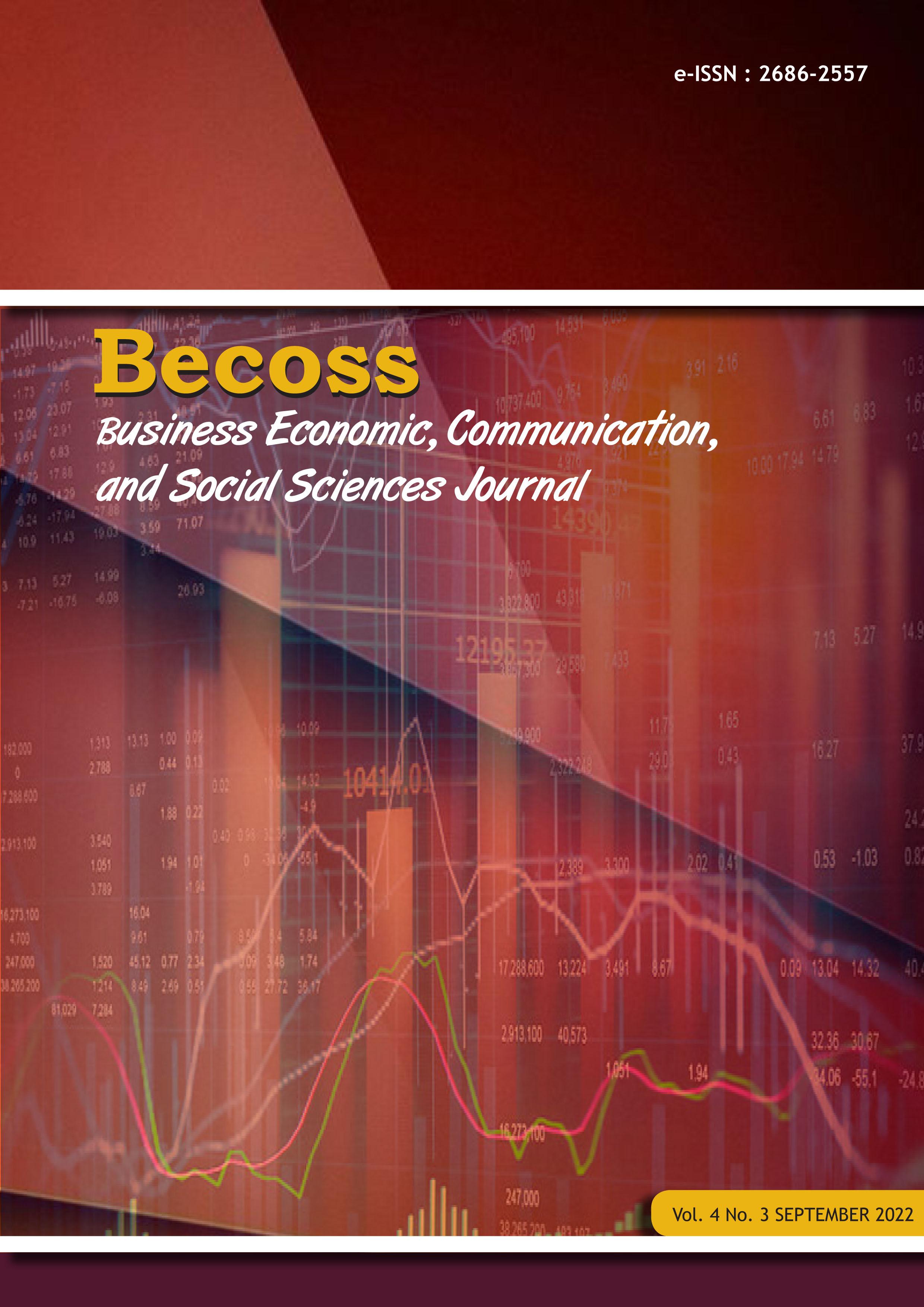Bitcoin, Gold, the Indonesian Stock Market, and Exchange Rate: GARCH Volatility Analysis
DOI:
https://doi.org/10.21512/becossjournal.v4i3.8671Keywords:
Bitcoin, Volatility, Gold Price, Stock Price, USD-IDR Exchange Rate, Investment Assets, Hedging InstrumentAbstract
Bitcoin has gained popularity as an investment asset because of its similarity to gold, which sparked the idea that bitcoin can be used as a hedging instrument to the fiat currency exchange rate. This paper aims to analyze bitcoin's volatility and return to gauge its feasibility as an investment asset, and hedging tool for the USD-IDR exchange rate with the GARCH and EGARCH models. With data on the daily closing price of bitcoin, gold, IDX composite index, and USD-IDR exchange rate from January 1, 2016, to December 31, 2020, the study attempts to find factors affecting bitcoin returns with the independent variables of bitcoin’s price, gold, and USD-IDR exchange rate by estimating their correlation. Following the analysis, this study shows that the volatility of USD-IDR exchange rates negatively influences bitcoin returns, making it a relatively safe investment asset. Additionally, the study found that bitcoin returns are not affected by the variables of gold price and the IDX composite index. However, we found that the USD-IDR exchange rate significantly affects bitcoin returns, while gold price and bitcoin’s price does not significantly affect bitcoin returns. Further, the analysis found that bitcoin is unsuitable for hedging due to its sensitivity to asymmetric shocks.
References
Acharjamayum, I., Patgiri, R., & Devi, D. (2019). Blockchain: A Tale of Peer to Peer Security. Proceedings of the 2018 IEEE Symposium Series on Computational Intelligence, SSCI 2018, 609–617. https://doi.org/10.1109/SSCI.2018.8628826
Algieri, B. (2012). Price Volatility , Speculation and Excessive Speculation in Commodity Markets : sheep or shepherd behaviour ? ZEF-Discussion Papers on Development Policy, 166, 1–37.
Arfaoui, M., & Ben Rejeb, A. (2017). Oil, gold, US dollar and stock market interdependencies: a global analytical insight. European Journal of Management and Business Economics, 26(3), 278–293. https://doi.org/10.1108/EJMBE-10-2017-016/FULL/PDF
Bhosale, J., & Mavale, S. (2018). Volatility of select Crypto-currencies: A comparison of Bitcoin, Ethereum and Litecoin. Annual Research Journal of SCMS, Pune, 6(March), 132–141. scmspune.ac.in/journal/pdf/current/Paper 10 - Jaysing Bhosale.pdf
Bordo, M. D. (2021). Gold Standard. In Econlib CEE. The Library of Economics and Liberty. econlib.org/library/Enc/GoldStandard.html
Ciaian, P., Kancs, D., & Rajcaniova, M. (2018). The price of Bitcoin: GARCH evidence from high-frequency data. Journal of Investment Strategies, 9(4), 1–18. https://doi.org/10.21314/JOIS.2021.005
Dyhrberg, A. H. (2016). Bitcoin, gold and the dollar - A GARCH volatility analysis. Finance Research Letters, 16, 85–92. https://doi.org/10.1016/j.frl.2015.10.008
Gersbach, H. (2019). Flexible majority rules for cryptocurrency issuance. https://doi.org/10.3929/ETHZ-B-000348480
Ghozali, R. (2017). Analisis Multivariat dan Ekonometrika Teori, Konsep, dan Aplikasi dengan Eviews 10 (Edisi 2). Badan Penerbit Universitas Diponegoro.
Glaser, F., Zimmerman, K., Haferkorn, M., Weber, M. C., & Siering, M. (2014). Bitcoin-Asset or Currency? Revealing Users’ Hidden Intentions. Twenty Second European Conference on Information Systems, 1–14. papers.ssrn.com/sol3/papers.cfm?abstract_id=2425247
Gujarati, D. (2019). Basic Econometrics (Sixth Edit). McGraw-Hill/Irwin.
Hartati, & Saluza, I. (2017). Aplikasi GARCH dalam Mengatasi Volatilitas Pada Data Keuangan. Jurnal Matematika, 7(2), 107. https://doi.org/10.24843/jmat.2017.v07.i02.p87
Hendrickson, J. R., & Luther, W. J. (2017). Banning bitcoin. Journal of Economic Behavior & Organization, 141, 188–195. https://doi.org/10.1016/J.JEBO.2017.07.001
Henriques, I., & Sadorsky, P. (2018). Can Bitcoin Replace Gold in an Investment Portfolio? Journal of Risk and Financial Management 2018, Vol. 11, Page 48, 11(3), 48. https://doi.org/10.3390/JRFM11030048
Juanda, B. J. (2021). Ekonometrika Deret Waktu Teori dan Aplikasi (Digital Ed). IPB Press.
Nakamoto, S. (2008). Bitcoin: A Peer-to-Peer Electronic Cash System. bitcoin.org/bitcoin.pdf
Ram, A. J. (2019). Bitcoin as a new asset class. Meditari Accountancy Research, 27(1), 147–168. https://doi.org/10.1108/MEDAR-11-2017-0241/FULL/XML
Shakil, M. H., Mustapha, I. M., Tasnia, M., & Saiti, B. (2018). Is gold a hedge or a safe haven? An application of ARDL approach. Journal of Economics, Finance and Administrative Science, 23(44), 60–76. https://doi.org/10.1108/JEFAS-03-2017-0052/FULL/PDF
Warsito, O. L. D. (2020). Analisis Volatilitas Cryptocurrency, Emas, Dollar, dan Indeks Harga Saham (IHSG). International Journal of Social Science and Business, 4(1), 40–46. https://doi.org/10.23887/ijssb.v4i1.23887
Wong, H. T. (2017). Real exchange rate returns and real stock price returns. International Review of Economics & Finance, 49, 340–352. https://doi.org/10.1016/J.IREF.2017.02.004
Zaghloul, E., Li, T., Mutka, M. W., & Ren, J. (2020). Bitcoin and Blockchain: Security and Privacy. IEEE Internet of Things Journal, 7(10), 10288–10313. https://doi.org/10.1109/JIOT.2020.3004273
Downloads
Published
How to Cite
Issue
Section
License
Copyright (c) 2022 Business Economic, Communication, and Social Sciences (BECOSS) Journal

This work is licensed under a Creative Commons Attribution-ShareAlike 4.0 International License.
Authors who publish with this journal agree to the following terms:
- Authors retain copyright and grant the journal right of first publication with the work simultaneously licensed under a Creative Commons Attribution License - Share Alike that allows others to share the work with an acknowledgment of the work's authorship and initial publication in this journal.
- Authors are able to enter into separate, additional contractual arrangements for the non-exclusive distribution of the journal's published version of the work (e.g., post it to an institutional repository or publish it in a book), with an acknowledgment of its initial publication in this journal.
- Authors are permitted and encouraged to post their work online (e.g., in institutional repositories or on their website) prior to and during the submission process, as it can lead to productive exchanges, as well as earlier and greater citation of published work.
USER RIGHTS
All articles published Open Access will be immediately and permanently free for everyone to read and download. We are continuously working with our author communities to select the best choice of license options, currently being defined for this journal as follows: Creative Commons Attribution-Share Alike (CC BY-SA)






